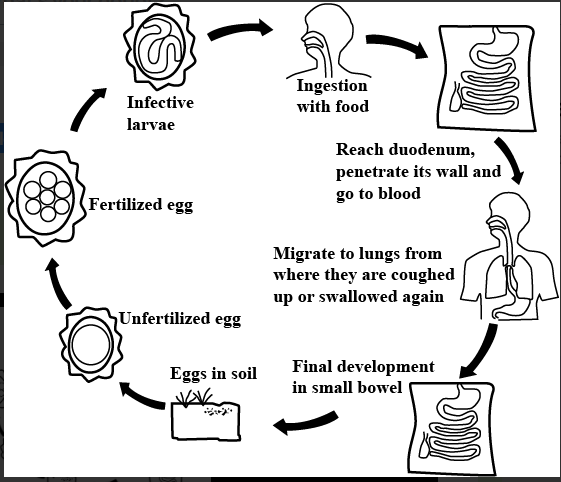
Describe the structure and life cycle of Ascaris lumbricoides with a neat labelled diagram.
Answer
426.9k+ views
Hint: Ascaris is nematode roundworms that live as parasites in the small digestive tract of humans. These worms belong to the Ascarididae family, the Secernentea class, and the Oxyurida request. These worms, also known as Ascaris suum, are commonly found in pigs.
Complete answer:
The Life Cycle:
1. The Egg: Adult Ascaris worms inhabit the dividers of the small digestive tract in humans. The female worm can grow to be 35 cm long and lays approximately 20,000 eggs, which are dropped into the environment by the human stool. Unfertilized eggs are ingested but are not infective, whereas treated eggs are infective and progress further in the following stage.
2. The Larvae: The treated eggs hatch into larvae. The hatchling then becomes infectious after 18 days to half a month, depending on natural conditions such as warmth, wetness, and soil district. Following ingestion, the prepared eggs produce hatchlings that attack the intestinal mucosa. They are transported from here to various parts of the body, such as the lungs. They then move toward the throat, where the worms can be gulped and returned to the digestive tracts to develop.
3. The Adult: When the hatchlings reach the small digestive tract, they mature into adult worms. At this stage, the mature worm produces an enormous number of eggs. From the time infective eggs are consumed to the time female grown-up worms oviposit, it takes about 2 to 3 months. Ascaris worms can live for 1 to 2 years when fully grown.

Note:
Individuals become contaminated by these worms when they consume food or water contaminated with Ascaris worm eggs. Ascaris relies on humans and pigs as hosts. Other common hosts for Ascaris include monkeys, dogs, and so on.
Complete answer:
The Life Cycle:
1. The Egg: Adult Ascaris worms inhabit the dividers of the small digestive tract in humans. The female worm can grow to be 35 cm long and lays approximately 20,000 eggs, which are dropped into the environment by the human stool. Unfertilized eggs are ingested but are not infective, whereas treated eggs are infective and progress further in the following stage.
2. The Larvae: The treated eggs hatch into larvae. The hatchling then becomes infectious after 18 days to half a month, depending on natural conditions such as warmth, wetness, and soil district. Following ingestion, the prepared eggs produce hatchlings that attack the intestinal mucosa. They are transported from here to various parts of the body, such as the lungs. They then move toward the throat, where the worms can be gulped and returned to the digestive tracts to develop.
3. The Adult: When the hatchlings reach the small digestive tract, they mature into adult worms. At this stage, the mature worm produces an enormous number of eggs. From the time infective eggs are consumed to the time female grown-up worms oviposit, it takes about 2 to 3 months. Ascaris worms can live for 1 to 2 years when fully grown.

Note:
Individuals become contaminated by these worms when they consume food or water contaminated with Ascaris worm eggs. Ascaris relies on humans and pigs as hosts. Other common hosts for Ascaris include monkeys, dogs, and so on.
Recently Updated Pages
The correct geometry and hybridization for XeF4 are class 11 chemistry CBSE

Water softening by Clarks process uses ACalcium bicarbonate class 11 chemistry CBSE

With reference to graphite and diamond which of the class 11 chemistry CBSE

A certain household has consumed 250 units of energy class 11 physics CBSE

The lightest metal known is A beryllium B lithium C class 11 chemistry CBSE

What is the formula mass of the iodine molecule class 11 chemistry CBSE

Trending doubts
State the laws of reflection of light

One Metric ton is equal to kg A 10000 B 1000 C 100 class 11 physics CBSE

Difference Between Prokaryotic Cells and Eukaryotic Cells

How do I convert ms to kmh Give an example class 11 physics CBSE

Describe the effects of the Second World War class 11 social science CBSE

Which of the following methods is suitable for preventing class 11 chemistry CBSE




